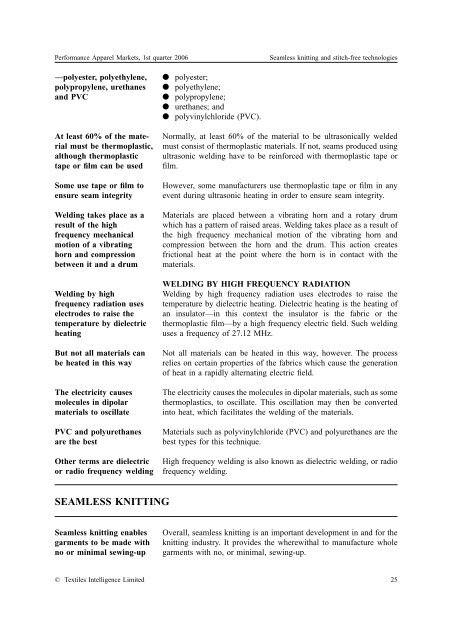Performance Apparel Markets - Grado Zero Espace Srl
Performance Apparel Markets - Grado Zero Espace Srl
Performance Apparel Markets - Grado Zero Espace Srl
You also want an ePaper? Increase the reach of your titles
YUMPU automatically turns print PDFs into web optimized ePapers that Google loves.
<strong>Performance</strong> <strong>Apparel</strong> <strong>Markets</strong>, 1st quarter 2006<br />
Seamless knitting and stitch-free technologies<br />
—polyester, polyethylene,<br />
polypropylene, urethanes<br />
and PVC<br />
At least 60% of the material<br />
must be thermoplastic,<br />
although thermoplastic<br />
tape or film can be used<br />
Some use tape or film to<br />
ensure seam integrity<br />
Welding takes place as a<br />
result of the high<br />
frequency mechanical<br />
motion of a vibrating<br />
horn and compression<br />
between it and a drum<br />
Welding by high<br />
frequency radiation uses<br />
electrodes to raise the<br />
temperature by dielectric<br />
heating<br />
But not all materials can<br />
be heated in this way<br />
The electricity causes<br />
molecules in dipolar<br />
materials to oscillate<br />
PVC and polyurethanes<br />
are the best<br />
Other terms are dielectric<br />
or radio frequency welding<br />
● polyester;<br />
● polyethylene;<br />
● polypropylene;<br />
● urethanes; and<br />
● polyvinylchloride (PVC).<br />
Normally, at least 60% of the material to be ultrasonically welded<br />
must consist of thermoplastic materials. If not, seams produced using<br />
ultrasonic welding have to be reinforced with thermoplastic tape or<br />
film.<br />
However, some manufacturers use thermoplastic tape or film in any<br />
event during ultrasonic heating in order to ensure seam integrity.<br />
Materials are placed between a vibrating horn and a rotary drum<br />
which has a pattern of raised areas. Welding takes place as a result of<br />
the high frequency mechanical motion of the vibrating horn and<br />
compression between the horn and the drum. This action creates<br />
frictional heat at the point where the horn is in contact with the<br />
materials.<br />
WELDING BY HIGH FREQUENCY RADIATION<br />
Welding by high frequency radiation uses electrodes to raise the<br />
temperature by dielectric heating. Dielectric heating is the heating of<br />
an insulator—in this context the insulator is the fabric or the<br />
thermoplastic film—by a high frequency electric field. Such welding<br />
uses a frequency of 27.12 MHz.<br />
Not all materials can be heated in this way, however. The process<br />
relies on certain properties of the fabrics which cause the generation<br />
of heat in a rapidly alternating electric field.<br />
The electricity causes the molecules in dipolar materials, such as some<br />
thermoplastics, to oscillate. This oscillation may then be converted<br />
into heat, which facilitates the welding of the materials.<br />
Materials such as polyvinylchloride (PVC) and polyurethanes are the<br />
best types for this technique.<br />
High frequency welding is also known as dielectric welding, or radio<br />
frequency welding.<br />
SEAMLESS KNITTING<br />
Seamless knitting enables<br />
garments to be made with<br />
no or minimal sewing-up<br />
Overall, seamless knitting is an important development in and for the<br />
knitting industry. It provides the wherewithal to manufacture whole<br />
garments with no, or minimal, sewing-up.<br />
© Textiles Intelligence Limited 25
















